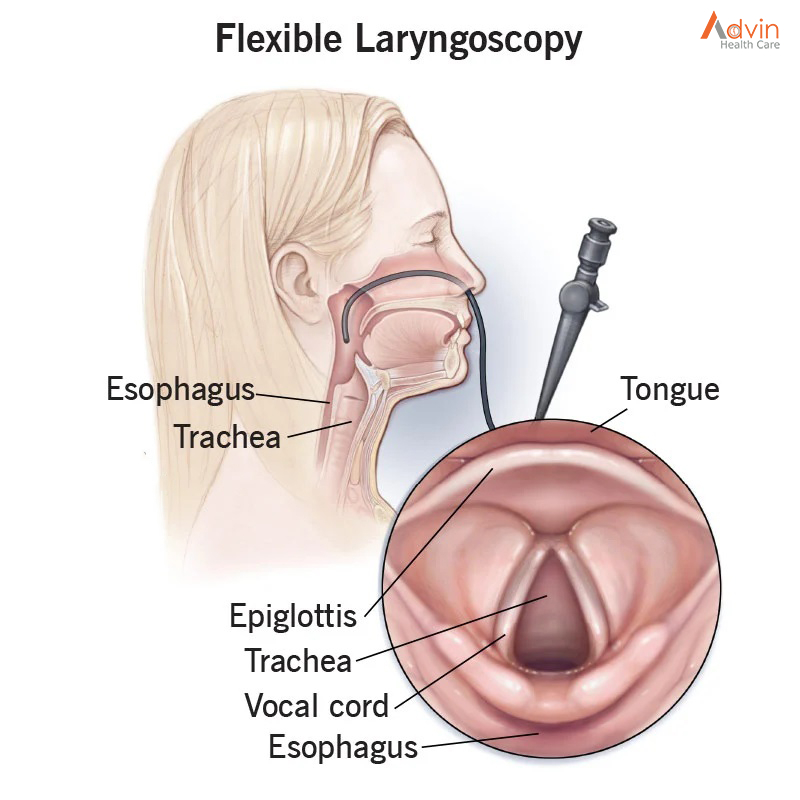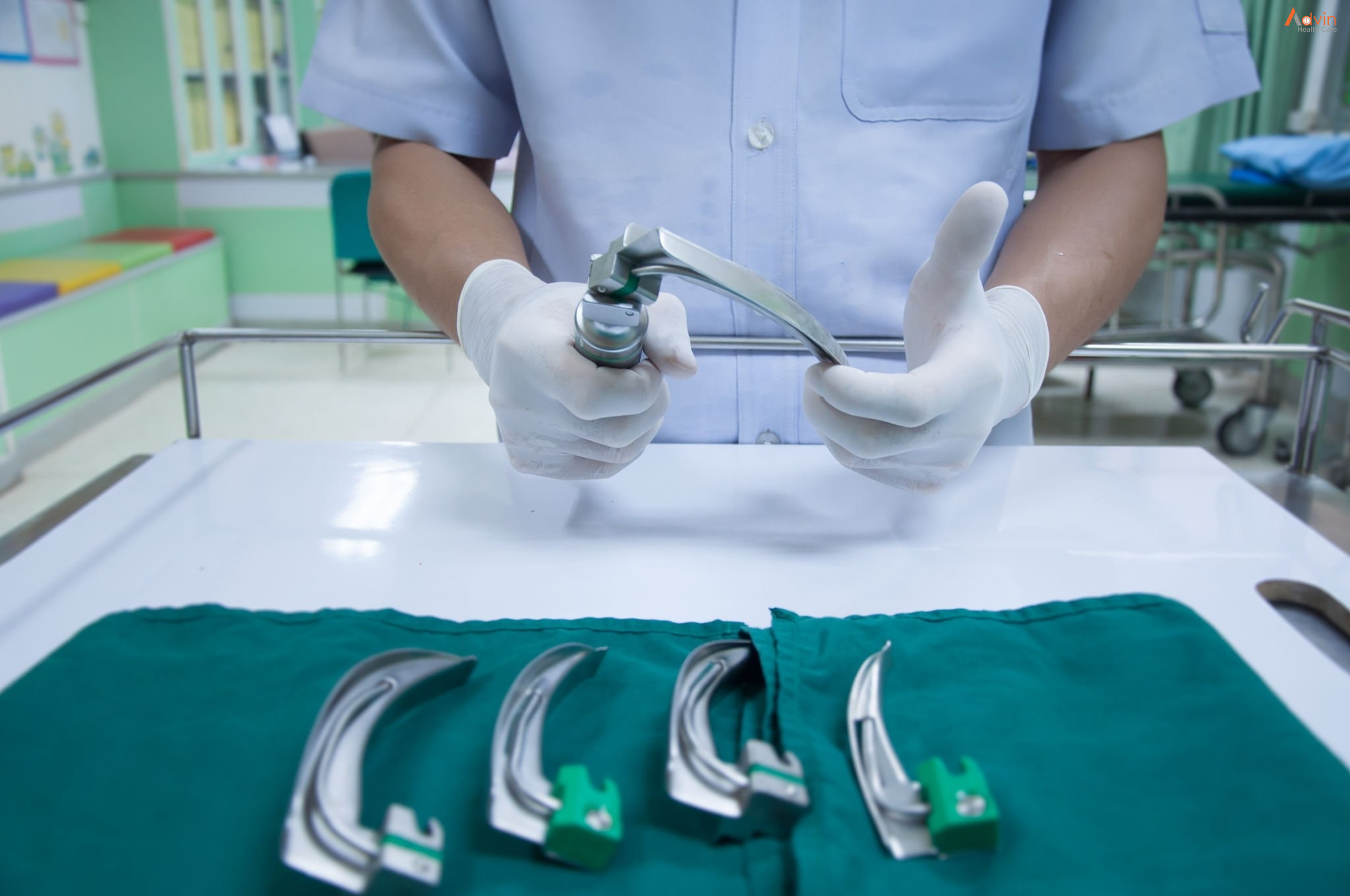A laryngoscopy is an examination that gives your doctor a close-up view of your larynx and throat. The larynx is your voice box. It’s located at the top of your windpipe, or trachea.
It’s important to keep your larynx healthy because it contains your vocal folds, or cords. Air passing through your larynx and over the vocal folds causes them to vibrate and produce sound. This gives you the ability to speak.
A specialist known as an “ear, nose, and throat” (ENT) doctor will perform the exam. During the exam, your doctor place a small mirror into your throat, or insert a viewing instrument called a laryngoscope into your mouth. Sometimes, they’ll do both.
A laryngoscopy is a procedure healthcare providers use to examine your larynx (voice box). This is performed with a laryngoscope, a thin tube with a light, lens and a video camera that helps providers look closely at your larynx. Providers may do laryngoscopies in a clinic office or as surgery in an operating room.
What is my larynx?
Your larynx is located between your throat and your trachea (windpipe). Your larynx houses your vocal cords (vocal folds), which enable you to speak and sing. Your epiglottis sits on top of your larynx. Your epiglottis is a flap that closes when you eat or drink so items intended for your esophagus (food pipe) don’t end up in your larynx or in your airway. When people talk about something going down the wrong pipe, the pipe they’re talking about is your larynx.
When is laryngoscopy needed?
Your doctor may do it to find out why you have a sore throat that won’t go away or to diagnose an ongoing problem such as coughing, hoarseness, or bad breath. They also might do one when:
- You have something stuck in your throat.
- You have trouble breathing or swallowing.
- You have an earache that won’t go away.
- They need to examine something that could be a sign of a more serious health problem such as cancer.
- They need to remove a growth.
Types of laryngoscopy
There are several ways your doctor may do this procedure:
Indirect laryngoscopy: This is the simplest form. Your doctor uses a small mirror and a light to look into your throat. The mirror is on a long handle, like the kind a dentist often uses, and it’s placed against the roof of your mouth.
The doctor shines a light into your mouth to see the image in the mirror. It can be done in a doctor’s office in just 5 to 10 minutes.
You’ll sit in a chair while the exam is done. Your doctor might spray something into your throat to make it numb. Having something stuck in your throat might make you gag, however.
Direct fiber-optic laryngoscopy: Many doctors now do this kind, sometimes called flexible laryngoscopy. They use a small telescope at the end of a cable, which goes up your nose and down into your throat.
It takes less than 10 minutes. You’ll get a numbing medication for your nose. Sometimes a decongestant is used to open your nasal passages as well. Gagging is a common reaction with this procedure as well.
Direct laryngoscopy: This is the most involved type. Your doctor uses a laryngoscope to push down your tongue and lift up the epiglottis. That’s the flap of cartilage that covers your windpipe. It opens during breathing and closes during swallowing.
Your doctor can do this to remove small growths or samples of tissue for testing. They can also use this procedure to insert a tube into the windpipe to help someone breathe during an emergency or in surgery.
Direct laryngoscopy can take up to 45 minutes. You’ll be given what’s called general anesthesia, so that you will not be awake during the procedure. Your doctor can take out any growths in your throat or take a sample of something that might need to be checked more closely.
I’m having a laryngoscopy what should I expect?
Your healthcare provider will consider your specific situation when deciding which type of laryngoscopy they’ll use. You may have your laryngoscopy in a clinic office or as a surgical procedure. For example, your provider may decide you should have a surgical laryngoscopy in an operating room. This is a direct laryngoscopy. Providers typically do direct laryngoscopies following in-office flexible laryngoscopies. Direct laryngoscopies may be done along with biopsies or other surgical procedures.
What happens before laryngoscopy?
If you’re having a surgical laryngoscopy, you’ll receive general anesthesia. Your provider will talk to you about getting ready for your procedure:
- You may need to fast the night before your procedure.
- You may need to avoid certain medications before your procedure.
- If you smoke, your provider may recommend you stop smoking a week or so before your procedure.
- You’ll need someone to give you a ride home after your surgery.
What happens during laryngoscopy?

Surgical laryngoscopies and clinic office laryngoscopies have different processes.
Laryngoscopy in an office clinic
- In some cases, your provider may use a small, tilted mirror and a bright light to examine your vocal cords.
- They also may use a flexible laryngoscope. This is a flexible fiberoptic scope inserted through your nose to look down your throat.
- Your provider will apply a small amount of numbing medicine and decongestant to your nose. The numbing medication may taste bitter.
- You may feel an urge to cough, but that urge is likely to subside.
- Your provider will then gently pass the flexible laryngoscope into a nostril and look down your throat.
- They may have you speak during the test to see how your voice box is working.
- In some circumstances, they may use a special scope that’s inserted through your mouth.
Direct laryngoscopy in the operating room
Your provider will use a special laryngoscope that’s inserted through your mouth. Because you had general anesthesia, you won’t feel anything.
What happens after laryngoscopy?
Different things happen depending on whether you had a surgical laryngoscopy or one done in an office clinic.
In-office clinic laryngoscopy
- Your nose and throat may feel numb for a few minutes after the procedure. This usually wears off in about 20 minutes.
- You should avoid eating or drinking while your mouth and throat are numb.
Operating room direct laryngoscopy
- You’ll go to the recovery unit after surgery to recover from anesthesia so your provider can watch for any complications or problems.
- You may have a mild sore throat and/or hoarseness. Your provider may want you to rest your voice for a while after your surgery.
What are the benefits of a laryngoscopy?
Your doctor is concerned that you may have a problem in your larynx. A laryngoscopy is a good way of finding out if there is a problem.
If your surgeon finds a problem, they can perform biopsies (removing small pieces of tissue) to help make the diagnosis. For some people, the treatment can be performed at the same time.
For some people minor treatments can be performed at the same time.


